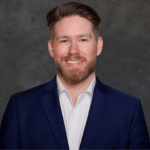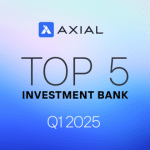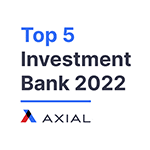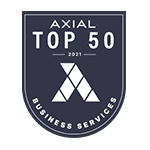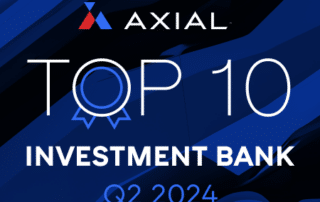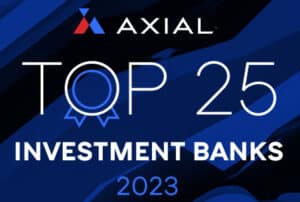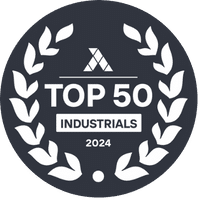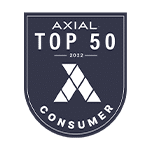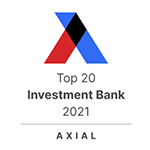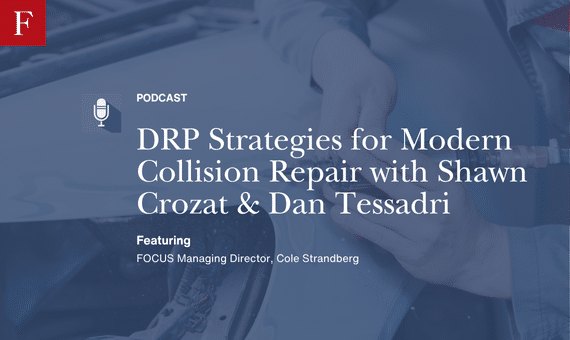
DRP Strategies for Modern Collision Repair with Shawn Crozat & Dan Tessadri
On this week’s episode, Cole Strandberg has a special panel-style discussion in our DRP series with two perspectives in the same room. Shawn Crozat, CEO of G&C Auto Body, a large California-based MSO whose company is built around great DRP relationships and high performance and Dan Tessadri, senior claims operations leader on the insurer side in auto physical damage with CSAA Insurance Group, a AAA Insurer. They discuss what each side truly looks for when selecting and sustaining DRP repair partners. How can they make those partnerships work better? And what’s changing in the DRP model as vehicles get more complex?
Cole Strandberg: Looking forward to an awesome conversation and a really unique conversation where we get to hear from both a shop perspective and an insurer perspective. Sean, this is your first time here on the Collision Vision, though your organization has been well represented by your brother Pat in the past. Would love to hear a bit about your background and GNC in your own words if I could.
Shawn Crozat: Sure. Cole. Yeah. My name is Sean Croza. I’m the CEO of GNC Auto Body. My dad started the business in 1972 in Santa Rosa. He was a painter in the Air Force and when he got out he started painting cars for a living. So it’s a business owned by me, my two brothers and my sister and mom. I became CEO nine years ago after my dad unexpectedly passed away. Love the business. We had about 15 locations up till 2020 till Covid and me and the brothers had a lot of free time on our hand during COVID and said hey, do we want to just sit still or do we want to try to grow fast? And we decided to grow fast. We had 15 in 2020 and we just opened number 53 on Monday and are continuing to keep growing every year. Our goal is 15 to 20% growth a year.
Cole Strandberg: Man. Congratulations on that growth. I know Auto Body News writes about you guys and the tremendous growth you have all the time. So very appreciative of your time here today and with you. You brought a great insurance partner. Dan, give us a quick introduction if you could.
Dan Tessadri: Yes, again, thank you for having me on, especially with such illustrious company as Sean.
Shawn Crozat: Oh wow.
Dan Tessadri: I Dantis Adri I am the senior manager responsible for APD process and performance for CSA which is a AAA organization. My responsibilities include the the Direct Repair Network, the DRN as we call it, as well as contracts, partners and pretty much APD strategy and a lot of those roles. So glad to be on.
Cole Strandberg: Wonderful. Thank you both Two very different, unique, awesome perspectives. Dan, I’m going to open up with a bit of a line of questioning directed towards you from the insurer perspective. What are the top criteria when you’re selecting a potential repairer to partner with on a DRP basis? What do you look for? What gets you excited?
Dan Tessadri: Sure. Well to start off, I think CSA as an organization has been in the insurance game. I think since we have a sort of internal anecdote that Woodrow Wilson was president and Ford invented the assembly line, that’s how long we’ve been in the business. So it’s been a long while building up our brand recognition and building up our membership. So it’s the reason I bring that up is that it is critically important for us from a membership organization standpoint that we look to partner with organizations that are focused on the customer, the member that look for technical insights, efficiencies that are leading the industry with repair quality and have that recognized brand that can mesh in with our brand to really provide our membership with a top notch experience from an overall process standpoint. So those are things that we really look for. We obviously have a fiduciary responsibility to our members being a reciprocal organization. So expense is important as every dollar is their dollar and that’s the way we look at it. So those are things that we look at from a standpoint of prospective partners. We’re not focused in on large MSOs only. We really want to partner with both the larger organizations, the mid tier or regional powerhouses like you know, Sean’s organization as well as single store operators or you know, small multi store operators that can provide that same level of experience that we’re looking for in providing to our membership.
Cole Strandberg: Fantastic. Appreciate kind of setting the table here for us. Obviously a lot to consider when it comes to A potential repair partner, things like cycle times and rework and overall quality plus facilities certifications. A lot to keep in mind. How do you kind of weigh that and compare that to in importance to call it cost, which you mentioned as well. All of which is going to come into play when, when selecting the right partner, I would imagine.
Dan Tessadri: I think they’re all same sides or different sides of the same pyramid. Right. So when you’re looking at it, you’re looking at not necessarily one being more important than the other, but they both, all of them actually hold up a strong presence. With regards to how we look at it, obviously services is a key factor. As with every other carrier in existence, you know, maintaining and retaining our customer base and membership base is incredibly important. So when you look at a repair facility and especially a DRN partner, we’re looking at partners that can enhance the experience and enhance the name of our organization and we want to do the same for them. We invest a lot in technology and performance criteria. So we definitely want partners that are forward thinking and looking at how best to approach technology, AI all of those aspects and incorporate them into sort of the new customer or the new repair process and experience. We’re heavily invested in maintaining, training and focusing on the understanding of the processes, the repair process. So we do a lot of work with ICAR and we expect our partners to be ICAR gold at a minimum. And we’re really sort of focused in on organizations that are innovating in their space, that are really focused in on being a leader from a quality perspective, but also doing things that looking at the next generation of repairs and how to overcome obstacles in getting those repaired effectively, efficiently and accurately.
Cole Strandberg: Obviously, every component of what we mentioned here about what we care about in a repair comes down to safe and proper repairs and customer satisfaction. Talk to me about how you guys view customer satisfaction, how you measure it, and how you keep the dialogue going between insurer and shop partner.
Dan Tessadri: So obviously as a, as a DRN or a drp, our partners are essentially the ones that are interacting with our members or customers face to face. Right. It’s those organizations that bear the brunt of that communication or that interaction. So we’re relying heavily on organizations that are supremely focused on servicing the customer, communicating effectively with the customer, communicating effectively, effectively with us, and really understanding the CSAA repair program. So enhancing that, that level of service and really being fine tuned with the needs from a business perspective because I mean, every organization in this country is focusing on cost, right? It’s par for course across the Board. And we obviously are not inured to the effect that this has on our members pocketbooks. So cost is always going to be an impactful component. But we’re looking for organizations to partner with that really understand the AAA way. The real focus in on the quality aspect, the longevity of the brand and acting as good stewards for that brand and also that we owe them that same level of commitment.
Cole Strandberg: Fantastic. Appreciate that perspective a ton. And Sean, thank you for your patience as we now move kind of to the shop piece of the conversation and then we’ll mesh this all together in the latter half of the conversation. Sean, we’ve had pat on, as I mentioned a couple times, GNC is very well represented here with Autobody News on the collision vision and across the industry, something we’ve spoken a lot about is your investment in DRP relationships and work. How do you evaluate opportunities to partner with insurers and what are you looking for in that relationship before you pull the trigger and get engaged?
Shawn Crozat: Well, Cole, we work with 13 out of 15 of the major insurers, so we find that every insurer we work with to be very reasonable. And, you know, we’re people dealing with people. So I haven’t found an insurer I couldn’t get along with. So I guess that’s kind of hard to really answer because there hasn’t been any bad relationships or insurers whose programs weren’t in keeping with our belief system.
Cole Strandberg: People dealing with people, man. I think that’s a fantastic way to put it and something to keep the perspective moving forward when Dan mentions a lot of their requirements and the pieces that are important to insurers in this, in this case of that relationship, what. Which criterias jump out to you as somewhere that you guys are really focused on being a great partner.
Shawn Crozat: So I think what Dan said is what probably all insurers want. They want great service for their, for their members or their insured. They want a quality repair. They want it done, you know, reasonably fast, and they want it done at a competitive price, I think are the main elements. And so that’s what we focus on as a shop group and what most of the scorecards we see on CCC for our insurers encompass. So we’re always looking for ways to increase our training to help us. How do we repair a car faster, how do we get more efficient? How do we improve our processes? How do we get our people better, you know, when it comes to costs, okay, how do we cut any waste in our, in our company? How do we improve our processes. Again, how do we use technology and harness technology to help our people be more efficient, to reduce the cost that we can pass on to our insurers? So I think, you know, everything Dan said is what we encompass in our company, and we’re always trying to improve upon that.
Cole Strandberg: You know, I think a theme here is the base case is you’re doing good work at a fair price the right way. That’s kind of the entry level stakes that you got to do as a collision repair today in this world. We have to do it. I think the thing that might set you guys apart, just a sneaking suspicion, is how you communicate that you’re doing all of these things with your partners. How do you view communication with Dan and organizations like his?
Shawn Crozat: Well, I think a lot of that information is available to them with the CCC scorecard. They. They know how we’re doing. It doesn’t have to be communicated from us. And maybe I misunderstand, Cole, but they can see how we’re doing against the market. They can see how our service stacks up against our peers, how our cycle time, how our severity, all those sort of things. And so it’s great that, you know, every Sunday, CCC updates us and lets us know how we’re doing and if we got better or worse. And so really, it’s. It’s. We all can see the scoreboard. There’s no secrets. There’s no. I remember back in the days, like. Like 25 years ago, and I was, as an estimator, my. My insurance guy would come in and he’d go, oh, Shawn, you got the highest severity in the market. You’re the most expensive, and your service is the worst. And I’d be like. And then he’d go, drive to the other shop in town, who’s my buddy, and he’d tell him the same thing, and then he’d tell the other guy the same thing. And. And it’s so different now, where we really are in partnership and we’re both having a line goal, and I think CCC has made that available to us. So we can really see are we competitive in the marketplace. Are we getting better or are we getting worse?
Cole Strandberg: No, extremely valid point. And, you know, it’s just. It’s rare to hear, so I want to peel the onion just a little bit. Such positivity around insurer relationships. And that might just be a state of mind and how you guys view that partnership as someone that’s pulling you into growth, that’s supporting you, that’s bringing you work and Ensuring that it’s a mutually beneficial relationship. But why, why are you guys so positive on that when it feels almost every other conversation out there, there’s this adversarial relationship between the insurer and the body shop. How would you suggest people kind of reframe how they view that relationship?
Shawn Crozat: You know, I think, I think if you’re pro growth and you want to grow your business, it really makes sense. I think that there’s probably people that are trying to get rich on it. Some people are trying to get rich on every car, and we’re trying to make a fair profit and fix a lot of cars. And that’s, that’s our philosophy, is that it’s a win win. And so I. I don’t know because I’m not, I’m not in their companies. I don’t know what they think, but I think we make a. We make a very good profit. We do very well. And, and having good relationships with our insurance partners allowed us to grow to the size that we are today. So I’m not sure their perspective, but it’s great for. Great for us.
Cole Strandberg: Your success speaks to itself, right? And you look at the biggest collision repairs across the country, none of them could be where they are today without insurance relationships. So there’s something to be said about a state of mind and how you view that relationship, and it makes total sense. Zooming out a little bit on your organization, obviously you’ve seen tremendous growth since COVID and that’s not an uncommon story, by the way, whether it’s 08, whether it’s Covid times of kind of some scariness happening in the world, fortune tends to favor the bold. And that’s certainly the case here. From a company perspective, how do you manage the challenges as you are growing of maintaining that high performance, that quality, that cycle time, that customer service across multiple locations, across multiple repairs, across multiple geographies to an extent. How do you view staying who you are and still being able to grow the way you’ve grown?
Shawn Crozat: Well, cool. That’s why I have all these gray hairs. Five years ago, we had 15 shops. It was brown hair, but we got.
Cole Strandberg: To zoom in more to see too many grays.
Shawn Crozat: I’m telling you, my camera’s not very good, so I guess because there’s plenty, but I mean, it’s not easy. I would start with, you need to have an incredibly good leadership team and always be developing more leaders and growing your people and you get results to your people. So we tell our people our three pillars of our company is Our people, our processes, and our culture. And if we have the very best people and the very, very best processes and the very best culture, then we’re going to be the best performers. So I know it’s kind of simple, but that is what we continue to focus on. And the better our people get and the better our leaders are, our general managers, our writers, you know, our technicians, the easier my job gets. But I think you definitely have to build a strong corporate support team. When I think about growth, if I could do it all over again, I wouldn’t have been as cheap, and I would have put some of that corporate team in ahead of time. I would have overstaffed some of those new locations, you know, and I made some mistakes in 2021 that probably gave me most of these gray hairs. But we’ve. We’ve gotten better at it over time.
Cole Strandberg: That’s what it’s all about, man. Hindsight’s 20 20. It obviously has worked out all right with you guys, and the momentum is just. It’s palpable. I want to continue diving into the relationship piece because that’s what we’re here to talk really primarily about today. Right. We have two sides of the process that are both extremely important to that process. Dan, you know, you nodded along when I mentioned the adversarial relationship and how Sean’s perspective is pretty refreshing there. What behaviors or practices from the best repairer partners you have can help build trust and stability in that relationship? What do you look for there?
Dan Tessadri: Sure. And, you know, just to preface that, I. You know, the DRP relationship obviously is a strategic relationship. I don’t think that every organization is interested in that from a repairer standpoint. Neither do I think that there are DRP platforms or programs out there that are focused in on potentially maintaining the relationship side of the fence more so than the efficiency or the financial aspect of it. You know, that being said, and going back to something Sean said earlier, I think Sean and I have had a relationship for about 20 years, so we’ve known each other through.
Cole Strandberg: Since kindergarten, apparently.
Dan Tessadri: Well, I’ll take that.
Shawn Crozat: Sadly, no. Yeah, we’re both kind of getting old.
Dan Tessadri
Yeah. But so we’ve been through some. Some interesting times. Some. Some. Some times where we’ve had to have discussions on serious matters. And we’ve been through those patches based off of the understanding that the communication that we need to have has to be clear and concise. And that, I think, is a critical cornerstone of any relationship, whether it be professional or whether it be personal. If you have a clear and concise method of an honest method of communicating and open to reciprocal feedback. I think that relationship will go a long way. That being said, it’s like I’m a firm believer in, you know, say what you mean and mean what you say because if you don’t, there’s going to be issues. And I hold myself to that same standard. And we at AAA at CSAA hold our own staff members to that same standard and we have dedicated team members that assist and work with Sean and his group to make that process as more seamless as it can as possible for that member who comes into those stores. So I think it’s critical you’re talking about the relationship piece. Communication is the first pillar. And I think also, you know, being innovative, being invested in technology, being invested in the future of this industry is critical as well.
Cole Strandberg: No, no question about it. And to your point, man, I always say this is a big industry, but it’s a small, small world and your word is your bond. Do what you say you’re going to do and, and you immediately just, it, it sets you up for a whole lot more success than the alternative. No question about it. Sean, you mentioned working with 13, I believe of the, the 15 major carriers in, in your geography at least I’m sure and we’re not going to get into any negativity toward anybody but I’m sure there are some of those relationships that are just a cut above the rest of the what insurer actions can help, how well repairs like you guys can perform, what sets the best of the best apart from the rest.
Shawn Crozat: I think not micromanaging is helpful. Our best relationships are ones that are more of a self manage where we know what our goals are, we’re given our goals and an opportunity to achieve them. And, and let us, you know, some of the insurers to kind of get out of our way and let us do. We’re extremely good at doing. So I would say our self manage relationships are our best. I would say the, the ones with the scorecards that, that we can really, that make sense to me and that we’re aligned with and some of the scorecards to me don’t always make the most sense. And, and I would say from insurer standpoint is some of our insurers do performance based referrals and some don’t. And so I feel that performance based referrals incentivize us to get better. We put more energy and time into it and training and we see a reward for our great performance. So those are our Very best relationships with our performance based ones. Awesome.
Cole Strandberg: Dan, I want to throw it to you as well. You know, I. I find myself moving in this direction in so many conversations on the collision vision about what separates the best from everyone else, because I think it’s a cool part of the listener base here. Anybody who’s listening to this conversation right now is listening because they want to get better. They want to be the best best. Dan, from your perspective, what separates the best shops in how they kind of work with and communicate with you?
Dan Tessadri: From everyone else, from a shop perspective, I would say those facilities that engender a culture of strong communication, strong training, strong adherence and open dialogue with our assigned staff, those are the ones that perform the best. The ones that ask the questions surrounding performance, surrounding opportunities, that are delving into their scorecards, that are knowing and understanding the impact of the numbers and the drivers of those numbers. And frequently we get responses from our membership and from other customers indicating that your repair facility knew the process was seamless with respect to understanding the CSA and the AAA service ethos as well as providing an excellent quality repair. It’s those organizations that really sort of, when the time comes when we have these discussions, whether they be monthly checkpoints or whether they be checkpoints, when our staff go out into the field to complete reviews and coaching and training sessions that ask those questions and are really involved and sometimes push back on items that we have that may not make sense to them and we have to really explain sort of the thought process behind and really underscore those items. Those are the relationships that I think develop the most. Because again, it comes back down to wanting to understand and wanting to partner and really being strategic about their decision to partner with that carrier.
Cole Strandberg: You mentioned the word conflict. Even in the best relationships, whether that be business or personal, conflict is going to exist. Dan, I’ll start with you, but I’m going to ask Sean the same question. How would you like your partners to address and handle conflict when that ultimately arises?
Dan Tessadri: From my perspective, everyone makes mistakes. We do. You know, again, it’s people dealing with people. As Sean alluded to in the beginning. I think what needs to be done in order to circumvent any bad blood or any issues regarding frustration is to not focus on the impediment, not focus on the particular barrier surrounding the relationship or the concern. But how do we prioritise a way through that impasse? Looking for the solution as opposed to focusing on. On the problem has always been one of the cornerstones of the way I like to do Business and the way that we’ve developed within CSA and the AAA sort of ethos of getting to the point where we resolve these matters and come to a satisfactory conclusion for our membership as well as for each other.
Cole Strandberg: Sean, how about you, man? When a conflict arises with an insurer partner, mistakes happen, to Dan’s point. Humans dealing with humans. To your point, how do you want to see that conflict get addressed and ultimately resolved from a good partner?
Shawn Crozat: I think most handled the same way. Kind of going back to what I said and Dan, you know, people, people dealing with people, sometimes people can get a little hot. But in the end, we both, we both want to take care of the customer and sometimes we have different information than the insurance adjuster has different OEM stuff or you know, people have a different background, what they’ve experienced through. And so it’s kind of both understanding each other and then both understanding that we both want what’s right. We both want to take care of the customer. We both want a quality repair. We both, you know, we want to be paid fairly. The, the adjuster wants to also pay us fairly. And understanding we all pretty much want the same thing. We may just be coming at it from different angles or different life experiences. And, you know, I haven’t found an instance where we couldn’t come up with a Win win solution. So it’s really that simple.
Cole Strandberg: Love, love, love it. You know, Win Win and, and I don’t know if you guys have heard the, the couple episodes this month that are out already. Win Win win scenarios continue to be a theme here in, in this series between DRPs and shops and all about those relationships. When you have the same end goal and a similar worldview in terms of wanting to do right by your end customer, there’s very little that can get in the way of that happening ultimately, regardless of how you go about doing it. Dan, I want to, I want to start.
Shawn Crozat: Can I comment on what you said though? I think Win Win Win is exactly it. Like the benefit of, of DRP programs really is to the benefit of the consumer. You know, when cars go to drp, they get, you know, for the most part great service experience. Their car is fixed faster at DRP than non drp, which helps the service experience and also reduces rental costs. And, and we’re able to repair cars to help keep cost under control as well. Things like free storage or reduced rates or just writing the estimate thoughtfully. A quality repair but not going overboard. And so that savings goes to the insurance company, which then is passed on to the consumer so really, it really is a win win. Like obviously I win from these relationships. Dan’s company wins, but also so does the member. The insured win by keeping insurance rates down.
Cole Strandberg: Eloquently put. And sometimes guests make our editor’s job very easy when it comes to finding short video clips to put on social. I have a feeling we’re gonna see that exact clip floating around social media here over the coming days.
Shawn Crozat: Very well.
Cole Strandberg: Well said and appreciate that a ton. Dan, I wanna, I wanna kick it to you and, and so many of the ends of our conversations here on the Collision Vision are requesting us to pull out a crystal ball and talk about where this industry is heading, what the future is going to hold for our listeners, which are largely leadership and owners of organizations across the collision repair industry. Dan, where do you see DRP models evolving and these relationships evolving over the next three to five years?
Dan Tessadri: So I think that I listened to your last podcast with the last conversation you had with a gentleman that is now, I think in the VC space and used to work at one of the large top three. And like every other industry, this one has paradigm shifts, has cyclic trends, has, has, you know, been impacted one way or another by certain events, be it, you know, Covid, for instance, where we saw the power dynamics shift and trend for some time on the other sort of side of the fence and now that we’re seeing sort of financial uncertainty and frequency drops, we’re seeing, you know, the pendulum shift. Technology is going to play a significant part in how DRP continues to evolve. The technology going into vehicles, the technology from an accident avoidance system that affects those vehicles, the technology that both carriers as well as repairers utilize to not just repair a vehicle, but complete an initial blueprint from a standpoint of an estimate and documentation. I think all of that is going to continue to benefit from the impact of increased technology, AI, and also see the negative side of that based upon, you know, obviously, you know, the detractors that those technological insights bring. So I think from that standpoint, we’re going to see a continuation of that. I think that for some, DRP may not be the way to go. I respect that decision entirely. It’s a repair facility’s ultimate decision on what to do with their relationship with the carrier. But there are also sort of strong non negotiables in potentially what you’re willing to do with respect to the relationship as it pertains to cost, as it pertains to service, as it pertains to the impact on your long term business. I think we need to be a lot more strategic in the way we select partners, not just the repairer, but the carrier themselves. And look at, you know, find those anchors, either from a carrier’s perspective in that market or from a repair perspective, find those anchors for your facility.
Cole Strandberg: Sean, I’m going to hit you with a very similar rendition of that question from a shop perspective, how do you see this world, the DRP world, the insurance relations evolving here over the next three to five years?
Shawn Crozat: I see them strengthening. I, I see more consolidation. You know, Caliber is trying to go public next year. That’ll be interesting to watch. Obviously any of these private equity companies or goals to sometime do that as well go public. So I think the bigger, just going to get bigger. There’s a lot of money coming to our space and I imagine the relationships will just get stronger with, with insurance companies. And I think DRP programs help help insurers be more competitive in the marketplace. So I see no reason why they wouldn’t try to expand that. And that’s obviously helped by the consolidation in our space of, you know, consolidators, including ourselves, are, we’re pro drp. We have great relationship with insurers.
Cole Strandberg: No, no question. And you know, it’s, it’s strengthening because I, I think people realize in our industry that the more powers that kind of join forces and work through problems together that are going to ultimately create a better outcome for our end customer who, I mean, it’s life and death, right? It’s a really good thing. A rising tide lifts all boats. I find myself saying that more and more in this industry. Sean, from your perspective, there’s. From my perspective, and then I’ll get yours. There’s been so much evolution over the past few years, technologically and otherwise, to the point where we’ve seen new like sub industries pop up and exist that service the collision repair industry, technology like ADAS, calibration, technological advances in the vehicles we’re fixing like EVs. It’s been some components of the wild, wild west. How have you guys worked with your partners to find a good solution when maybe there’s not some sort of widely adopted solution nationwide?
Shawn Crozat: I think you work your way through it, possibly fumble your way through it. If I think back seven, eight years ago, when scans first became a conversation, and maybe five years ago calibrations became a conversation, there wasn’t information out there. There wasn’t a lot of o position statements. We were learning. And so it’s, it’s a lot of learning. It’s a lot of Conversations, you know, and you kind of work through it. And I’m sure there’ll be all new, different technology five years ago that I can’t even think of will exist or a problem that will exist five years from now. And I think, I just think about a change in general, right? So like Covid hits, like, California was one of the states that really shut down. Like, okay, sales are down 30%. We’re like, oh, we’re in trouble. We’re bleeding money. And then California reopens. I think it was June 2022. We skyrocket with work. We’re. We’re totally slammed. And then April last year, it starts dipping again. You know, the same time you brought in calibrations and all different kind of things seven years ago, who was talking about Tesla? So I think, I think the name of the game is having a really good culture and great leadership team to know that you don’t really know what the future is going to bring. But if you have really smart, dedicated people that are always learning and growing, you can pivot quick and you can pivot faster than your competition. And that’s what we focus on.
Cole Strandberg: No doubt. Dan, you were on the other side, although collectively rowing the boat in the same direction, I’m sure. As we’re tackling scans and calibrations and all that stuff, I would be shocked if there wasn’t some friction out there between your organization and some. Some partner shops. How do you go about addressing that and what do you see that looking like moving forward?
Dan Tessadri: So I think, and our partners may be able to attest to this, we’ve been really at the forefront of accepting the OEM standards and requirements with respect to scans and calibrations. We’ve really been focused on making sure that our partners do so as well because of the importance of getting that vehicle done the first time and being done properly the first time. So those are things that we’ve looked to educate ourselves around by speaking to repairers, be they the larger ones, the smaller ones, the marm and paps. We’ve spoken to myriad suppliers as well out there and really look to understand the process. Because you mentioned the Wild West, I term it more of a gold rush. Right. Because everyone essentially has. Has tried to come to the table with, with potentially making as much as they can off of a lot of these things. And again, I’m not impugning anyone for doing so that, that, you know, business is business, the market is the market. That being said, we as an organization have really looked in to dialing in Our approach from an educated standpoint around the whys behind it, the processes behind it, and the impact that that would have without being done correctly. So we’ve been doing a lot of sort of reflection around that. We, you know, like every carrier, we have questions and like every carrier, we will eventually land on a space where we have our own specific requirements and specifications around documentation and potentially price. Right. That’s a norm. But I think getting to that space needs to be from an aspect of learning and understanding before coming out with a stance on this is what we’ll do with calibrations. I’ve spoken to Sean at length around this as one of the advisors to sort of our process. So, you know, he can attest to some of the questions and some of the conversations that we’ve had. Those are the things that really will be able to long term separate us from the competition as well. Because just like Sean has competition, we have the same. And we’re striving for retention, we’re striving for new membership, but we’re also striving to ensure that these vehicles get repaired for the OEM spec.
Cole Strandberg: That’s what it all comes down to. Absolutely. Gentlemen, this has been awesome and insightful and we like to try to end each episode of the collision vision by putting a bow on the conversation with some actionable insights that, that listeners and shop owners can take away. So Sean, I want to start with you, man. You guys have had such a cool path toward growth. It’s become such a great and well known organization across the country for folks who want to follow in your footsteps, albeit at a smaller scale. Who they. They might not be a DRP partner, but they want to position themselves for the future and to kind of maximize what that future could look like. What advice would you give folks to set up for success?
Shawn Crozat: Gotcha. So just be clear, Cole. The question is someone who’s not a direct repair shop, but looking to become a direct repair shop.
Cole Strandberg: Absolutely right.
Shawn Crozat: It’s probably not the pretty bow you want on it, but I would say it’s going to be tough. Now is not a good time. And the time to have probably gone after drps when you had really because part of the track record. Right. Like we have a track record of performance. And so, you know, as we grow, Dan can kind of expect what we’re going to be able to do in the future based we’ve done in the past. We’re used to DRPs, the documentation, everything in CCC. So I would think that now would be a Hard time to get on DRPs. At least I know in California they’re saying claims volumes down to 10 to 20%. I would think their best option would be OEM certifications and specifically probably high, high line OEM certifications would probably be your best. But I would say that it certainly is a tough, it’s a lot tougher now to get on a DRP even for us then, then 18 months ago than before the, the market started to slide. So it certainly is, is a lot more challenging.
Cole Strandberg: I will tell you what though, my friend, it, it doesn’t have to be all lovey dovey fake great news to be a pretty bow. I think that’s very actionable and good insights. Dan, how about you? From your perspective?
Dan Tessadri: Yeah, from my perspective I think it goes back to something I said earlier. Be strategic. Understand what you’re willing to do and what your non negotiables are with respect to potential partnership concessions or how you want your work to be appreciated by a partner. I think you need to be focused in on technology. I think you need to really understand repair procedures, OEM specs and abide by them. Don’t cut corners and don’t partner with folks who want you to cut corners because I hear that a lot as a negative from a standpoint of where the industry sees the DLP relationship. The carrier wants you to cut a corner. I’ve been in this business for over 20 years. I’ve never asked anyone to cut a corner. And I’ve worked shop side, I’ve worked the carrier side. It’s up to the individual. It’s up to the individual to really understand who they are, what they want. Be strategic. Understand the impacts of a relationship within a shop ecosystem, how that will affect your staff, how that will affect your ability to grow and really look to those partners who align with their philosophy.
Cole Strandberg: Fantastic. Great nuggets of wisdom for our listeners, guys. Really do appreciate your time. Dan, for folks who want to connect with you and follow along with you and your organization, where can they do that?
Dan Tessadri: I do have a LinkedIn profile. I believe I’m on it every now and again. But folks can find me on there and obviously they can reach out to me at CSAA or you know, I’m sure Sean will be throwing my number out as he, as he frequently does.
Shawn Crozat: Oh, ouch.
Cole Strandberg: What is Dan Cell for everyone listening here at home.
Dan Tessadri: I have two phones.
Cole Strandberg: Just kidding, just kidding.
Dan Tessadri: Sean is one of those guys who has my personal number, I’ll tell you that.
Cole Strandberg: Yeah, fantastic. No, no, no, no cell phone number for Dan here, Sean, but for folks who want to get in touch with you, follow along with your journey and the journey of gnc. Where can they do that?
Shawn Crozat: Well you got an anti social media guy so I have no social media so follow my brother Pat on LinkedIn.
Cole Strandberg: I love it. We will incorporate. I love it man. We are going to incorporate all of that in the show. Notes to make it easy for everybody. Just one click for each of those. Dan, Sean, really appreciate you guys for joining us here on the Collision Vision.

